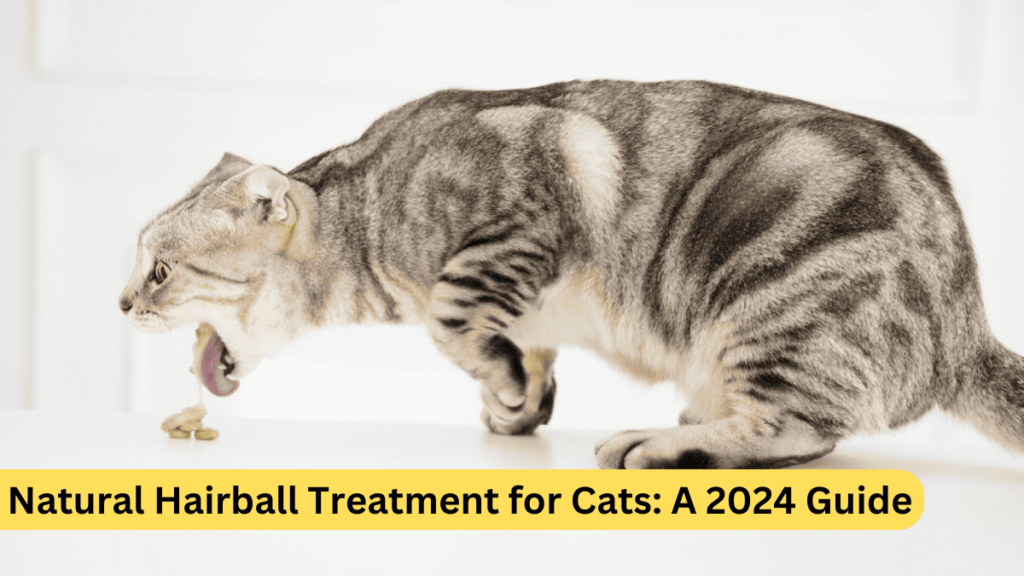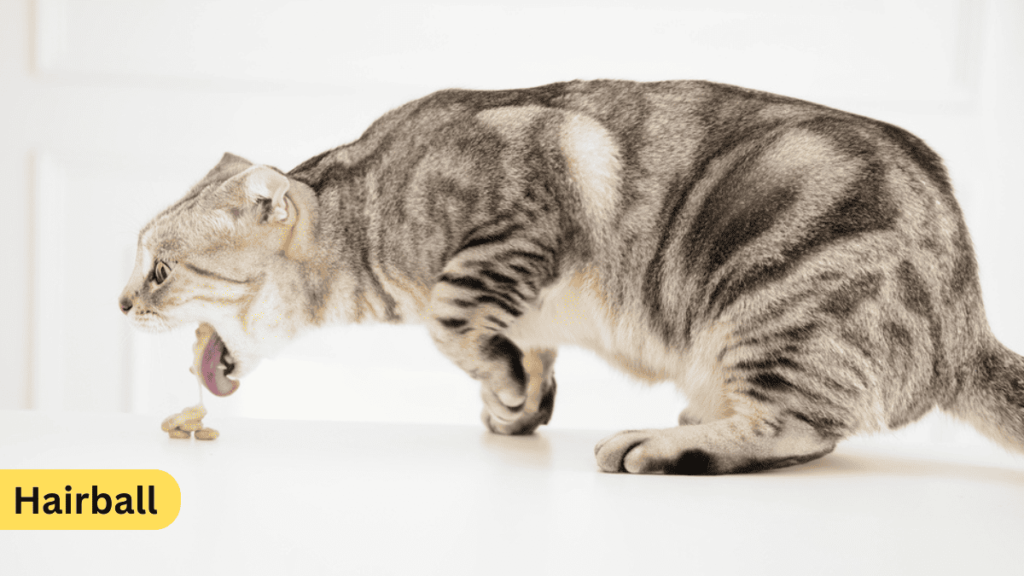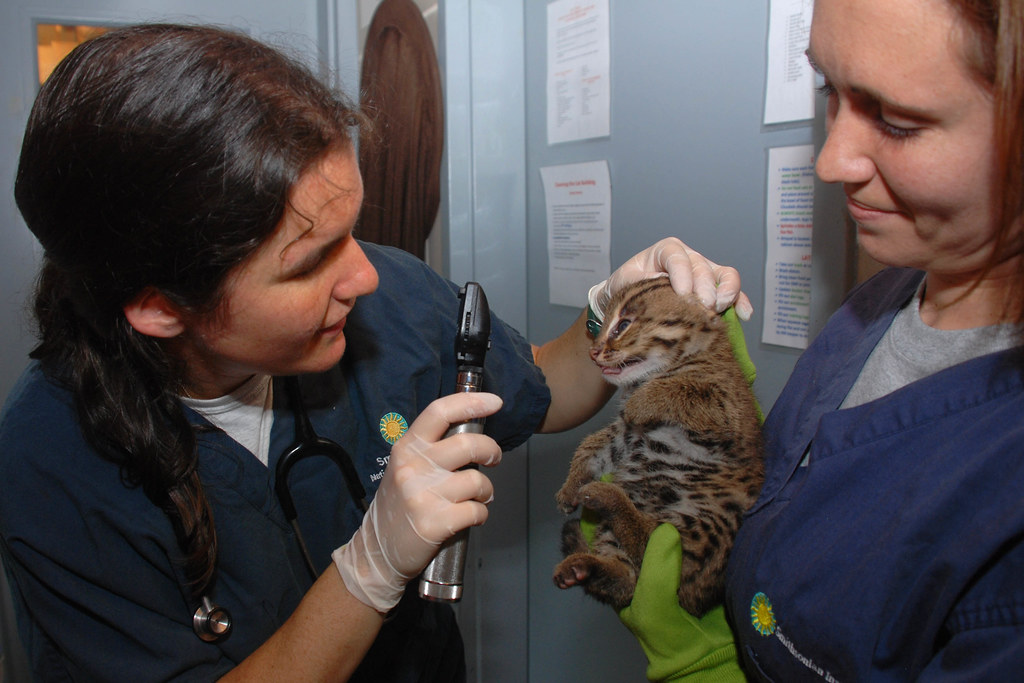
Cats are known for their meticulous grooming habits, but frequent grooming can lead to hairballs. If you’re a cat parent, you’ve probably dealt with the hacking sound of your feline trying to cough one up. While occasional hairballs are normal, persistent issues may indicate the need for an effective, natural solution. In this guide, we’ll explore the best natural hairball treatment for cats in 2024, answer common questions, and provide tips to help your cat stay hairball-free.
Table of Contents
What is a Hairball?

A hairball, also known as a trichobezoar, forms when cats swallow loose hair during grooming. Most of the ingested hair passes through their digestive system, but some remains in the stomach and forms into a ball. Over time, this hair may be vomited up in the form of a cylindrical-shaped mass. While hairballs are generally harmless, frequent occurrences can indicate a problem and discomfort for your cat.
Why Opt for Natural Hairball Treatment for Cats?
Natural treatments are gentle and free from harsh chemicals, making them a healthier option for your pet. Many over-the-counter solutions may contain ingredients that could cause allergies or upset your cat’s stomach. With natural alternatives, you can address hairball issues while promoting overall digestive health.
Best Natural Hairball Treatments for Cats in 2024
1. High-Fiber Cat Food
Increasing your cat’s fiber intake can aid digestion and help move hair through the system, reducing the formation of hairballs. Some cat foods are specifically formulated to address hairball issues and are enriched with natural fiber sources like pumpkin, sweet potatoes, or psyllium husk.
How It Helps:
- Fiber adds bulk to the stool, helping your cat eliminate hair naturally.
- Promotes better digestive health.
Tip: Check your cat’s food label for fiber content and consider switching to a hairball control formula.
2. Regular Grooming Sessions
One of the simplest and most effective natural treatments for hairballs in cats is regular grooming. Brushing your cat at least a few times a week reduces the amount of loose hair they ingest.
How It Helps:
- Reduces the amount of hair your cat swallows during self-grooming.
- Creates bonding time between you and your pet.
Tip: Use a brush that suits your cat’s fur type. Long-haired breeds may need more frequent grooming than short-haired cats.
3. Natural Oils
Adding certain oils to your cat’s diet can lubricate their digestive system, helping to prevent hairball formation. Olive oil, coconut oil, and fish oil are excellent choices.
How It Helps:
- Oils coat the digestive tract, helping hair move through the system smoothly.
- Provides essential fatty acids for a shiny, healthy coat.
Tip: Start with a small amount—about a teaspoon of oil—added to your cat’s food a few times per week.
4. Pumpkin Puree
Pumpkin is a popular natural hairball treatment for cats due to its high fiber content. Canned, unsweetened pumpkin puree (not pumpkin pie filling) can be added to your cat’s meals.
How It Helps:
- Fiber-rich pumpkin promotes regular bowel movements.
- Helps push ingested hair through the digestive system.
Tip: Start by mixing 1 teaspoon of pumpkin puree into your cat’s food daily and adjust as needed.
5. Cat Grass
Many cats enjoy nibbling on grass, which can help with digestion and may even help prevent hairball formation. Cat grass (wheatgrass) is safe for cats to eat and can be grown at home.
How It Helps:
- Helps cats naturally expel hair before it can form a hairball.
- Contains natural enzymes that support digestive health.
Tip: Grow cat grass indoors in a pot to give your cat access to this healthy treat year-round.
6. Hydration
Proper hydration is key to preventing hairballs, as it helps keep the digestive system functioning smoothly. Encourage your cat to drink more water by providing fresh water daily or using a water fountain, which many cats find more appealing.
How It Helps:
- Keeps the digestive system hydrated and moving.
- Helps prevent constipation, which can worsen hairball issues.
Tip: If your cat is reluctant to drink water, try offering low-sodium chicken broth or mixing water into their wet food.
Comparison of Natural Hairball Treatments
| Natural Treatment | How It Helps | Recommended Use |
|---|---|---|
| High-Fiber Cat Food | Adds bulk to stool and aids digestion | Transition to a hairball control formula |
| Grooming | Reduces loose hair ingested during grooming | Brush 2-3 times a week (more for long-haired cats) |
| Natural Oils (Coconut, Olive, Fish) | Lubricates digestive tract | Add 1 tsp to food a few times per week |
| Pumpkin Puree | Fiber-rich and promotes regularity | 1 tsp mixed into food daily |
| Cat Grass | Aids digestion and prevents hairball formation | Allow cat to nibble on grass regularly |
| Hydration | Promotes healthy digestion | Ensure fresh water or use water fountain |
Natural Hairball Prevention Tips

In addition to the treatments above, here are some tips to prevent hairballs naturally:
- Increase Wet Food Intake: Wet food contains more moisture than dry kibble, which aids in digestion and can help prevent hairballs.
- Use Hairball Control Treats: Some treats are specifically designed to reduce hairballs by promoting digestion.
- Environmental Enrichment: Engaging your cat in playtime can reduce excessive grooming that leads to hairballs.
Read More:
Natural Cat Flea Treatment in 2024: A Complete Guide
Frequently Asked Questions (FAQs)
1. What is the Best Natural Hairball Treatment for Cats?
The best natural treatment for hairballs in cats depends on your cat’s individual needs. High-fiber foods, pumpkin puree, and adding natural oils to their diet are all excellent options to start with.
2. Can I Give My Cat Coconut Oil for Hairballs?
Yes, you can give your cat small amounts of coconut oil as a natural remedy. It helps lubricate their digestive tract, making it easier for hair to pass through.
3. How Often Should I Groom My Cat to Prevent Hairballs?
Regular grooming can greatly reduce hairballs. For long-haired breeds, daily grooming may be necessary, while short-haired cats can benefit from being brushed 2-3 times a week.
4. How Much Pumpkin Should I Give My Cat for Hairballs?
A small amount of pumpkin (about 1 teaspoon) mixed into your cat’s food daily is sufficient to promote healthy digestion and reduce hairball formation.
Conclusion
While hairballs are an inevitable part of a cat’s life, there are several natural hairball treatments for cats that can help reduce their frequency and ensure your cat stays comfortable. By incorporating high-fiber foods, regular grooming, natural oils, and more, you can help your feline friend live a hairball-free life. Try these natural treatments for hairballs in cats and see what works best for your pet.
